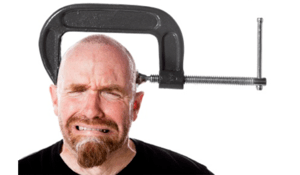As an example of everything that’s wrong with the orthodox approach to smoking cessation we need look no further than an online feature from Helpguide.org called How to Quit Smoking – A Guide to Kicking the Habit for Good.
This is wrong from the very first word. You don’t need a how-to guide to quitting smoking. You just need to quit! Also, please note, smoking isn’t a habit: it’s drug (nicotine) addiction.
In the next sentence it tells you quitting can be tough. Well, thanks for the encouragement. In reality it’s only going to be tough if you think it will be, and a guide such as this is likely to confirm your fears. Au contraire, quitting smoking is easy if you go about it the right way.
Learn about your options and prepare for quitting…manage your cravings
Why do you need ‘options’ to quit? You just need to quit! Then it seems you’ll have ‘cravings’ which will need to be ‘managed’. What does cravings mean anyway? Someone on their hands and knees, slavering at the mouth?
This is followed by a number of suggestions of What you can do to stop smoking. But you don’t have to do anything: you just need not to light the next cigarette.
Here’s a selection from the list, with my comments added:
Quit smoking cold turkey. This is the best way, but calling it ‘cold turkey’ is discouraging by implying it will be hard.
Systematically decrease the number of cigarettes you smoke. Doesn’t work.
Reduce your intake of nicotine gradually over time. Doesn’t work
Use nicotine replacement therapy or non-nicotine medications to reduce withdrawal symptoms. Discouraging and counter-productive to suggest you need nicotine when you’re trying to get free from nicotine addiction, or worse, you might even need prescription drugs!
Utilize nicotine support groups. Implies it’s too difficult to do on your own,
Try hypnosis, acupuncture, or counseling using cognitive behavioral techniques. Ditto
They continue with the following kind of inaccurate and discouraging information:
Smoking tobacco is both a physical addiction and a psychological habit…smoking is ingrained as a daily ritual. It may be an automatic response for you to smoke a cigarette with your morning coffee, while taking a break from work or school, or during your commute home at the end of a long day.
As Donald Trump would say, ‘Wrong!’ Smoking is nothing to do with a daily ritual or automatic response with a coffee or taking a break, etc. These ideas come from a failure to appreciate that smoking is drug addiction – and nothing else. A smoker has an abnormal need to replace the nicotine in his or her bloodstream when the level starts to fall soon after stubbing out the last cigarette – irrespective of what else he or she happens to be doing at the time.
To successfully quit smoking, you’ll need to address both the addiction and the habits and routines that go along with it.
The Trumpian interjection again. It’s only the addiction with needs to be ‘addressed’ – the habits and routines will take care of themselves.
While some smokers successfully quit by going cold turkey, most people do better with a plan to keep themselves on track…It should also be tailored to your specific needs and smoking habits.
Wrong yet again. The only plan you need when you’ve stopped smoking is to stay stopped. If you understand why you really smoke in the first place, this is easy. Nothing needs to be ‘tailored to your specific needs and smoking habits.’ All smokers have the same problem: nicotine addiction, and their need is to get free. It must be understood that smoking is not a habit.
Take the time to think of what kind of smoker you are, which moments of your life call for a cigarette, and why.
This just makes it unnecessarily complicated. The apparent ‘call’ for a cigarette is determined mainly by the time since the last one. And the reason for this is because the smoker will experience mild withdrawal symptoms shortly after the previous cigarette is extinguished.
Is it a very bad addiction (more than a pack a day)? Or are you more of a social smoker? Would a simple nicotine patch do the job?
Addiction is addiction – it’s illogical and unhelpful to think in terms of degrees of addiction. A ‘social smoker’ is still a smoker. And as for ‘a simple nicotine patch,’ is there a complicated nicotine patch? If you want to stop smoking you presumably want to get rid of nicotine in any shape or form.
They also suggest the following:
One of the best things you can do to help yourself quit is to identify the things that make you want to smoke, including specific situations, activities, feelings, and people.
This is the worst thing you can do. How about just getting on with your life?
It continues in similar vein and I won’t bore my readers by critiquing the whole of it, but let’s just look at what they have to say about withdrawal symptoms and how to deal with them.
Keep a craving journal.
A craving journal can help you zero in on your patterns and triggers. For a week or so leading up to your quit date, keep a log of your smoking.
Note the moments in each day when you crave a cigarette: what time was it? How intense was the craving (on a scale of 1-10)? What were you doing? Whom were you with? How were you feeling? How did you feel after smoking?
Words (almost) fail me. As someone who’s stopped smoking you want to forget about cigarettes.
Managing unpleasant feelings such as stress, depression, loneliness, fear, and anxiety are some of the most common reasons why adults smoke. When you have a bad day, it can seem like cigarettes are your only friend.
We all have times of depression, loneliness, fear, etc. How do non-smokers cope? For easy quitting it’s important to understand why cigarettes may provide the illusion of helping on a bad day, for illusion it is.
Then they really get into their stride by copying from somewhere these alleged common nicotine withdrawal symptoms, which, we are warned can go on for weeks: cigarette cravings, irritability, frustration, anger, anxiety or nervousness, difficulty concentrating, restlessness, increased appetite, headaches, insomnia, tremors, increased coughing, fatigue, constipation or upset stomach, depression, decreased heart rate. (Paraphrased.)
But don’t despair. Some helpful suggestions are given for dealing with these problems, such as: distract yourself; take a brisk walk, hot baths or naps; avoid pushing yourself; avoid stress; drink water or plenty of fluids, eat low calory snacks; add fiber to diet; exercise; find an oral substitute to pop in your mouth when cravings hit.
You’re going to be so busy doing all this you won’t have time to smoke. Maybe that’s the idea.
Text © Gabriel Symonds


Leave A Comment